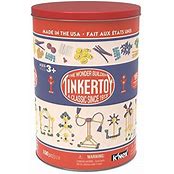It was an ordinary day. Doing some more cleaning around the house, trying to find items that we no longer need or use that we can sell or give away so when we make a move into a retirement community we have less to take with us. In our third bedroom we have both a rather large closet filled with old toys as well as a few chests also filled with toys from the past. The other day I had the best time looking at all the building blocks that our family had accumulated since my childhood. Boxes of Lincoln Logs, Tinkertoys and small American red plastic bricks that were the predecessor of today' Lego sets. My parents bought me a large set of Lincoln Logs when I was a young child.

 |
| The early LEGO blocks |
He was a master joiner and carpenter who opened a small woodworking shop with is son Godtfred who was just 12 years old at the time. They manufactured stepladders, ironing boards and eventually wooden toys. In 1934 they dubbed their business LEGO, a contraction of the Danish "leg got" ("play well"). The company expanded from 6 employees in 1934 to 40 in 1942. The company was the first Danish company to own a plastic injection-molding machine. They saw a British toy that was based on plastic blocks in 1947 and with a few changes came up with a toy two years later that were blocks with pegs on top and hollow bottoms which allowed children to lock the bricks together and create elaborate structures. They called their blocks "Automatic Binding Bricks" that were the forerunner of today's LEGO bricks. The one thing they didn't have was the small tubes that are found in today's LEGO blocks. In 1958 the LEGO brick finally came into its own. It was Godtfred Christiansen who pioneered and patented the now-standard LEGO stud-and-tube configuration, and introduced roof bricks to the "LEGO System of Play." LEGO hasn't changed their design since when they began making them in 1958. Then in 1961 the LEGO wheel was invented and today makes about 300 million wheels per year. They now package about 37,000 LEGO sets per hour. Their standards are so precise that they only find about 18 defective bricks out of every million bricks they make every day. In 2009 a British TV presenter by the name of James May built a life size house out of LEGO.  |
| James May's house made of LEGO. |
He used 3.3 million bricks and it included a working toilet, shower and a bed which is said to be very comfortable. And if you're wondering...the plural of LEGO is LEGO. The building blocks of today are so much different than they were when I was a child playing with my Lincoln Logs. But isn't everything today so much different than they were 70 plus years ago? It was another extraordinary day in the life of an ordinary guy,





No comments:
Post a Comment